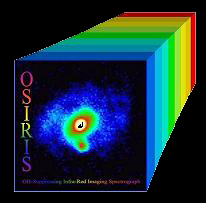 |
OSIRIS
Updates and News
OSIRIS hardware and major software changes are posted here. Please
follow this website to determine which calibration scans you should use for
your reductions.
|
The most unique step within the OSIRIS pipeline is the extraction of the spectra from the 2-dimensional raw frames. This process requires that the PSF of every lenslet as a function of wavelength has been mapped to fairly high precision. These PSFs are stable over many months and the calibration is performed by either the instrument team or Keck staff. We refer to these scans as Rectification Matrices, and they are stored in matrix form for all modes. In addition, arc lamp calibration scans are taken to perform a global wavelength solution for each lenslet. In the event of hardware changes to OSIRIS that significantly alter the optical path or components, new scans are taken and will be made available to you. The user does not need to take any of this calibration data, but does need to obtain the necessary matrices from the Keck repository for their observing modes (filter and platescale). In most cases, the OSIRIS Support Astronomer will give you the calibration scans for your observations.
Download calibration scans: Keck Calibration Scans
Observations from January - May 2005: use Rectification/Wavelength Scans and "old" pipeline version for these reductions taken March 2005 (ie, for Kbb in 0.02" scale the rectification file is s050327_c013___infl_Kbb_020.fits)
January 2005 - First Calibration Scans (Rectification and Wavelength) at Keck with the old grating
February 22, 2005 - First light with OSIRIS
Observations from June 2005 - February 2006: use Rectification Scans taken in June 2005 (i.e., s050623_c014___infl_Kbb_020.fits) with pipeline, a global wavelength solution is applied
June 2005 - New grating is installed
November 23, 2005 - Last night of Commissioning
Observations from April 2006 - present: use Rectification Scans taken in March 2006 for 0.02", 0.035", 0.05" lenslet scales in all filters, and 0.1" lenslet scale for J and Z broad/narrow band modes. For H and K broad/narrow band modes in 0.1" lenslet scale use Rectification Scans taken in May 2007.
March 2006 - Adjusted lenslet tilt and added new pupils to reduce the background in 0.035" and 0.05" lenslet scales
August 2006 - Public release of Data Reduction Pipeline
May 18, 2006 - Bad channel on SPEC detector appeared
June 27, 2006 - Fixed bad channel on SPEC detector
October 15, 2006 - Earthquake (6.7) occurred 10 km off-shore, southwest from Puako. This resulted in a broken G10 support of the optical bench, which in turn made a thermal short and restricted the dewar cooling.
Decemeber 2006 - Fixed broken rear G10 support for the optical bench (damaged in earthquake). OSIRIS scans were not affected.
April 2007 - Second public release of Data Reduction Pipeline (*major* changes to modules include: Remove Crosstalk, Extract Spectra, Assemble Data Cubes, and Mosaic Frames). Also we released new versions of the Quicklook2 package and Observing Planning GUI.
May 2007 - New 0.1" lenslet scale scans are taken for all H and K broad and narrow band modes to fix saturation effects from the March 2006 scans. In addition, the small number of bad array elements in all the rectification files have been fixed and updated to Keck repository. Please contact Jim Lyke to retrieve new rectification matrices for your observed modes.
June 9, 2007 - Version 2.0 public release of Data Reduction Pipeline, Data Reduction GUI, OSIRIS manual, Quicklook2 package, and Quicklook2 User's Manual.
June 29, 2007 - Version 2.1 public release of Data Reduction Pipeline, Data Reduction GUI, OSIRIS manual, Quicklook2 package, and Quicklook2 User's Manual.
Observations from March 2008 - December 2008: For the new Kcb, Kc3, Kc4, and Kc5 modes (K filters with 100mas new pupil) use the new rectificaiton matrices made in March 2008. For the other modes, use Rectification Scans taken in March 2006 for 0.02", 0.035", 0.05" lenslet scales in all filters, and 0.1" lenslet scale for J and Z broad/narrow band modes. For H and K broad/narrow band modes in 0.1" lenslet scale use Rectification Scans taken in May 2007.
March 6, 2008 - OSIRIS servicing mission to correct for global and relative focus shifts seen in each of the spatial scales, and to install duplicate Kbb, Kn3, Kn4, and Kn5 with new 100mas (9m effective) pupils, this new combo is called Kcb, Kc3, Kc4, and Kc5 and require their own rectification matrices.
February 2009 - OSIRIS servicing mission to correct for global and relati
ve focus shifts seen in each of the spatial scales, and to fix CCR cold head assembly and correct for a thermal contact and restore OSIRIS to a proper operating temperature. See Keck Report.
Observations from January 2009 - September 2009: OSIRIS had thermal issues during this period and the detector is operating ~8-10K warmer than normal operating temperatures. This caused noticeable changes in the performance of the OSIRIS pipeline. Users with the data sets post January 2009 are recommended to reduce their data using v2.3 pipeline.
October 14, 2009 -OSIRIS was serviced. They fixed the thermal contact between the cold head and copper block. After cooling down, OSIRIS returned to normal operating temperatures.
Observations from October 2009 - present: Users should use the latest calibration files generated by v2.3 of the calibration reduction pipeline (released to Keck January 2010).
Back to UCLA OSIRIS Home Page
UCLA Infrared Laboratory Home Page
Keck OSIRIS Home Page
OSIRIS Team Page (password required)

